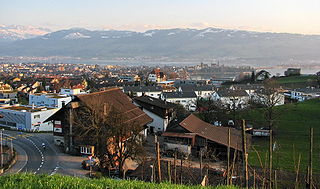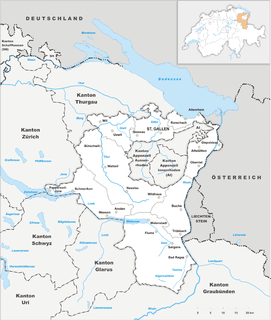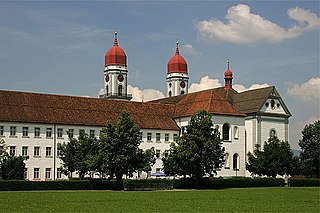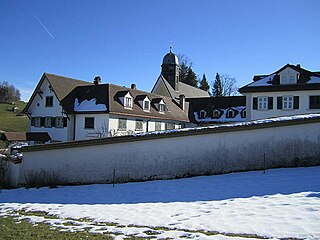
Rapperswil-Jona is a municipality in the Wahlkreis (constituency) of See-Gaster in the canton of St. Gallen in Switzerland. Besides Rapperswil and Jona, which were separate municipalities until 2006, the municipality includes Bollingen, Busskirch, Curtiberg, Kempraten-Lenggis, Wagen, and Wurmsbach.

The canton of St. Gallen, also canton of St Gall, is a canton of Switzerland. The capital is St. Gallen.

Appenzell is a historic canton in the northeast of Switzerland, and entirely surrounded by the canton of St. Gallen.

Rorschach is a municipality, in the District of Rorschach in the canton of St. Gallen in Switzerland. It is on the south side of Lake Constance (Bodensee).

St. Gallen or traditionally St Gall, in German sometimes Sankt Gallen is a Swiss city and the capital of the canton of St. Gallen. It evolved from the hermitage of Saint Gall, founded in the 7th century. Today, it is a large urban agglomeration and represents the center of eastern Switzerland. Its economy consists mainly of the service sector. The city is home of the University of St. Gallen, one of the best business schools in Europe.

Sion is a Swiss town, a municipality, and the capital of the canton of Valais and of the district of Sion. As of December 2019 it had a population of 34,710.

The Diocese of Sion is a Roman Catholic ecclesiastical territory in the canton of Valais, Switzerland. It is the oldest bishopric in the country and one of the oldest north of the Alps. The history of the Bishops of Sion, of the Abbey of St. Maurice of Valais as a whole are inextricably intertwined.

Rheinau Abbey was a Benedictine monastery in Rheinau in the Canton of Zürich, Switzerland, founded in about 778 and suppressed in 1862. It is located on an island in the Rhine.

Wattwil is a municipality in the Wahlkreis (constituency) of Toggenburg in the canton of St. Gallen in Switzerland. On 1 January 2013 the municipality of Krinau merged into Wattwil.

Berg is a municipality in the Wahlkreis (constituency) of Rorschach in the canton of St. Gallen in Switzerland.

Gommiswald is a municipality in the Wahlkreis (constituency) of See-Gaster in the canton of St. Gallen in Switzerland. On 1 January 2013 the former municipalities of Rieden and Ernetschwil merged into the municipality of Gommiswald.
The Sarganserland is a constituency (Wahlkreis) of the canton of St. Gallen, Switzerland, with a population of 36,892.

St. John's Abbey in the Thurtal was a Benedictine monastery originally established in Alt St. Johann in the Canton of St. Gallen, Switzerland, in the mid-12th century.

The Capuchin Friary, Rapperswil, is a Capuchin friary located in Rapperswil in the Canton of St. Gallen, Switzerland.

Fahr Convent, is a Benedictine convent located in the Swiss municipality of Würenlos in the canton of Aargau. Located in different cantons, Einsiedeln Abbey and Fahr Convent form a double monastery, overseen by the male Abbot of Einsiedeln, no converse arrangement appears to be available for the Abbess of Fahr. Fahr and Einsiedeln may be one of the last of such arrangements to survive.

St. Urban's Abbey is a former Cistercian monastery in the municipality of Pfaffnau in the canton of Lucerne in Switzerland. It is a Swiss heritage site of national significance.

Tänikon Abbey is a former Cistercian nunnery in the village of Ettenhausen in the municipality of Aadorf in the canton of Thurgau in Switzerland. The former abbey church and the conventual buildings, now Agrotechnorama Tänikon, are both Swiss heritage sites of national significance.

Centum Prata is the name of a Roman Vicus, whose remains are located on the eastern Zürichsee lakeshore in Kempraten, a locality of the municipality Rapperswil-Jona in the canton of St. Gallen in Switzerland. Centum Prata is the most important archaeological site from the Gallo-Roman era in the canton of St. Gallen.

The chapel of Notre-Dame de Posat is a Roman Catholic chapel located in the village of Posat of the Gibloux commune, canton of Fribourg, Switzerland. It is listed as a heritage site of national significance.

Wonnenstein Friary or Mary's Rose Garden Wonnenstein is a monastery of Sisters of the Third Order of Saint Francis in Teufen in the canton of Appenzell Ausserrhoden in Switzerland. While it is located in Appenzell Ausserrhoden, the buildings and grounds are a small exclave of the canton of Appenzell Innerrhoden.




















